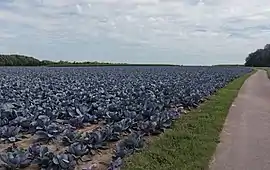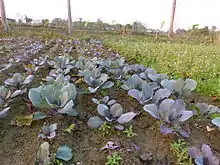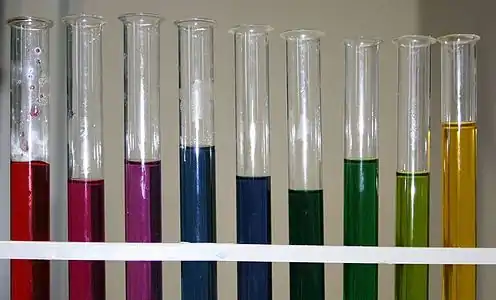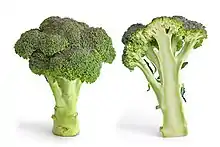Red cabbage
The red cabbage (purple-leaved varieties of Brassica oleracea Capitata Group) is a kind of cabbage, also known as Blaukraut after preparation. Its leaves are colored dark red/purple. However, the plant changes its color according to the pH value of the soil, due to a pigment belonging to anthocyanins.[1] In acidic soils, the leaves grow more reddish, in neutral soils they will grow more purple, while an alkaline soil will produce rather greenish-yellow coloured cabbages. This explains the fact that the same plant is known by different colours in various regions. It can be found in all Europe, throughout the Americas, in China and especially in Africa.
| Red cabbage | |
|---|---|
 | |
| Red cabbage plant | |
| Scientific classification | |
| Kingdom: | |
| (unranked): | |
| (unranked): | |
| (unranked): | |
| Order: | |
| Family: | |
| Genus: | |
| Species: | B. oleracea |
| Cultivar Group | |
|
Brassica oleracea Capitata Group | |

The juice of red cabbage can be used as a home-made pH indicator, turning red in acid and green/yellow in basic solutions. On cooking, red cabbage will normally turn blue; it is necessary to add vinegar or acidic fruit to the pot to retain the cabbage's red color.[2]
Red cabbage needs well fertilized soil and sufficient humidity to grow. It is a seasonal plant which is seeded in spring and harvested in late fall.[3] Red cabbage is a better keeper than its "white" relatives and does not need to be converted to sauerkraut to last the winter.
Uses
| Nutritional value per 100 g (3.5 oz) | |
|---|---|
| Energy | 122 kJ (29 kcal) |
6.94 g | |
| Sugars | 3.32 g |
| Dietary fibre | 2.6 g |
0.09 g | |
1.51 g | |
| Vitamins | Quantity %DV† |
| Vitamin A equiv. | 0% 2 μg0% 20 μg |
| Folate (B9) | 6% 24 μg |
| Vitamin C | 41% 34.4 mg |
| Vitamin K | 45% 47.6 μg |
| Minerals | Quantity %DV† |
| Potassium | 6% 262 mg |
| |
| †Percentages are roughly approximated using US recommendations for adults. Source: USDA FoodData Central | |
Red cabbage is often used raw for salads and coleslaw. This vegetable can be eaten cooked. It is the traditional accompanying side dish paired with many German meals, notably meat dishes like Sauerbraten or Döner. At Christmas it can be spiced, braised and served as an accompaniment to seasonal roast goose or turkey. Often apples are added to give it sweet-sour taste.
Cultivation

.JPG.webp)
It is recommended to start red cabbage seeds indoors 4 weeks before the last frost. Sow in containers that allow for movement of water through the bottom of a cell. Popular seedling starting containers are peat pots, egg cartons, plug trays or milk cartons. Once the seedlings grow to about 5 centimetres (2 inches) tall, and have developed their first leaves, they can be hardened off and moved outside for transplanting. Red cabbage prefers climates that remain moist and cool for most of its vegetative growth stage, so they can be placed in the ground shortly after the last frost, while the spring is still cool. The cabbage plants can be spaced about 30–65 cm (12–26 in) from one another. They will need watering often but are otherwise low maintenance plants.[4]
pH indicator

Red cabbage contains an anthocyanin-based dye that can be used as a pH indicator. It is red, pink, or magenta in acids, (pH < 7), purple in neutral solutions (pH ≈7), and ranges from blue to green to yellow in alkaline solutions (pH > 7).[5]
Nutrition
Red cabbage has a high content of vitamin C and vitamin K, containing 44% and 72%, respectively, of the Daily Value (DV) per 100-gram amount (right table of USDA nutrient values).[6]
Basic research on cabbage phytochemicals is ongoing to discern if certain cabbage compounds may affect health or have anti-disease effects. Such compounds include sulforaphane and other glucosinolates which may stimulate the production of detoxifying enzymes during metabolism.[7] Studies suggest that cruciferous vegetables, including cabbage, may have protective effects against colon cancer.[8] Cabbage is a source of indole-3-carbinol, a chemical under basic research for its possible properties.[9]
References
- "Where does the color come from in purple cabbage?". HowStuffWorks. 2000-08-07. Retrieved 2019-03-14.
- "How to Keep Red Cabbage Red When Cooking". LIVESTRONG.COM. Retrieved 2019-03-14.
- "How To Grow Red Cabbages - Vegetable Gardening". www.quickcrop.ie. Retrieved 2019-03-14.
- Alex (2017-12-05). "How to Grow Red Cabbage". Plant Instructions. Retrieved 2019-03-14.
- "Red Cabbage Lab: Acids and Bases" (pdf)
- "USDA database table for raw red cabbage per 100 g". US Department of Agriculture, National Nutrient Database for Standard Reference, version SR-27. 2018. Retrieved 13 April 2019.
- Dinkova-Kostova AT, Kostov RV (2012). "Glucosinolates and isothiocyanates in health and disease". Trends Mol Med. 18 (6): 337–47. doi:10.1016/j.molmed.2012.04.003. PMID 22578879.
- Tse, G; Eslick, G.D. (2014). "Cruciferous vegetables and risk of colorectal neoplasms: a systematic review and meta-analysis". Nutrition and Cancer. 66 (1): 128–139. doi:10.1080/01635581.2014.852686. PMID 24341734.
- Wu, Y.; Feng, X.; Jin, Y.; Wu, Z.; Hankey, W.; Paisie, C.; Li, L.; Liu, F.; Barsky, S. H.; Zhang, W.; Ganju, R.; Zou, X. (2010). "A novel mechanism of indole-3-carbinol effects on breast carcinogenesis involves induction of Cdc25A degradation". Cancer Prevention Research. 3 (7): 818–828. doi:10.1158/1940-6207.CAPR-09-0213. PMC 4214069. PMID 20587702. Lay summary – Science Daily (June 30, 2010).
External links
| Wikimedia Commons has media related to Brassica oleracea var. capitata f. rubra. |
